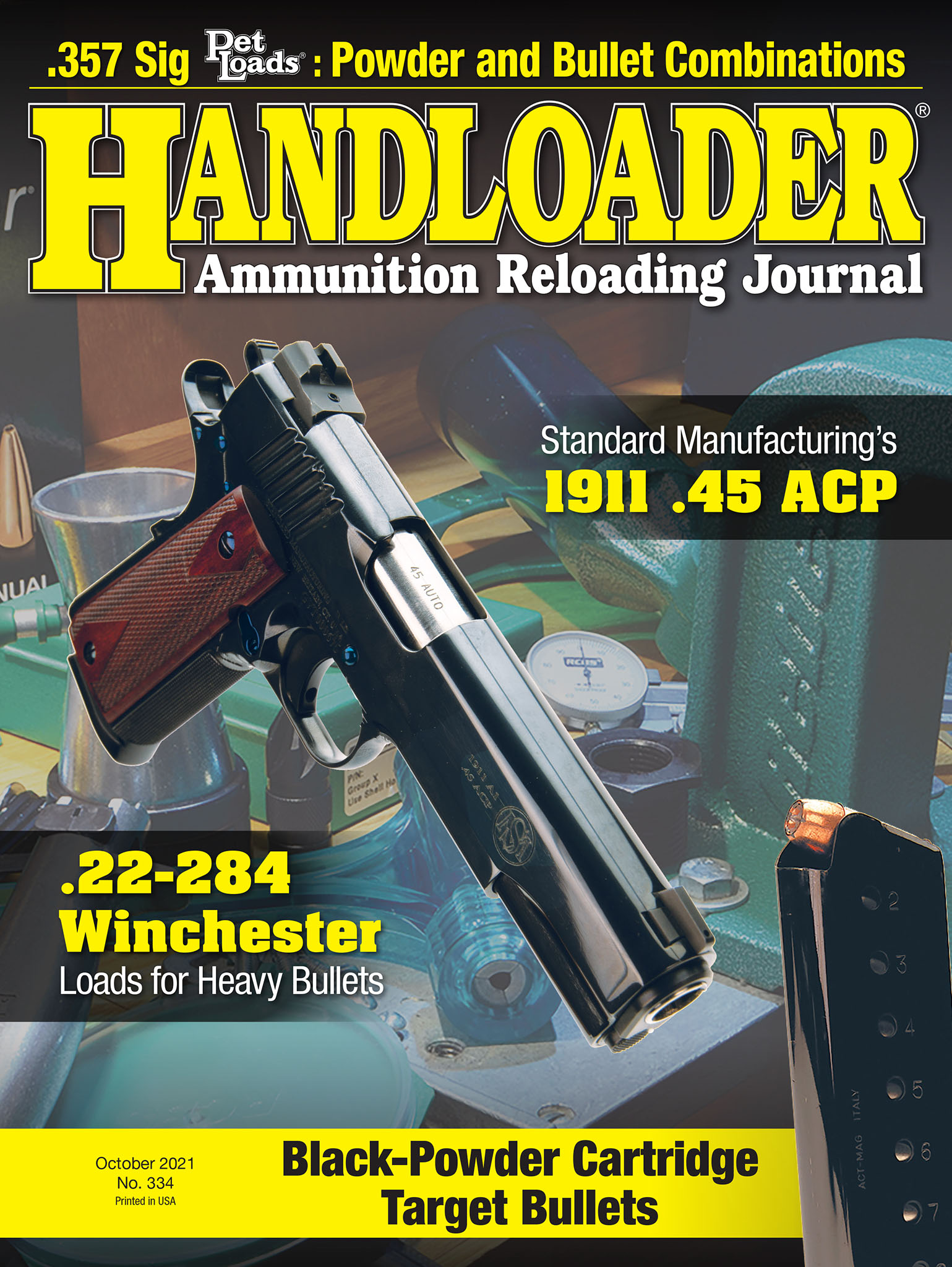Bullets & Brass
Hunting Loads for a .45-70 Levergun
column By: Brian Pearce | October, 21
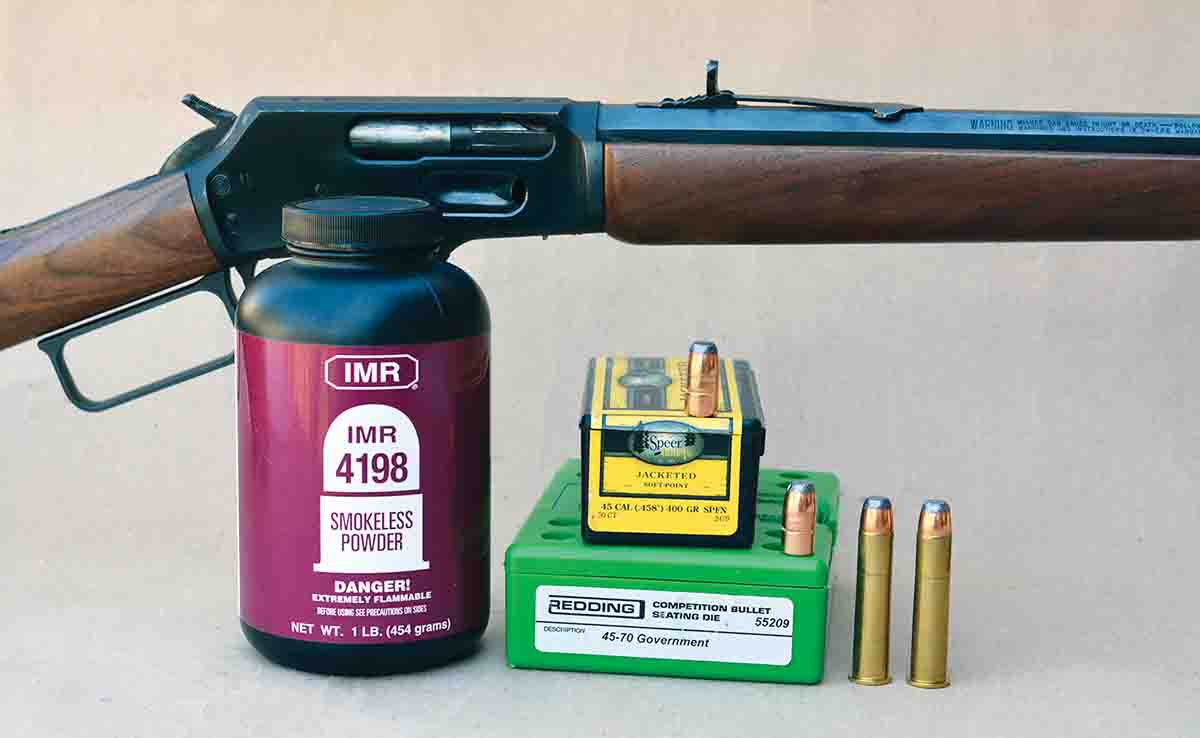
I would like a handload that will push the 400-grain Speer JSP bullet to around 1,600 to 1,700 feet per second (fps) and will give similar accuracy to the above Remington factory load. I don’t want to go higher in velocity, as I don’t want to deal with much more recoil.
The only powder that I have on hand is IMR-4198, as there are no other powder options available at local dealers. The problem is that the only IMR-4198 data I can find is limited to low pressure for the U.S. 1873 Trapdoor. I have new Starline cases and once-fired Remington cases and Winchester WLR primers. Any data that you can offer will be appreciated. I also very much appreciate your articles in Handloader and look forward to each new issue.
J.M., Birmingham AL
A: IMR-4198 powder will serve you well in the .45-70; however, due to its comparatively fast burn rate, it will not give top velocities. Nonetheless, it will reach 1,600 to 1,700 fps with the 400-grain Speer bullet that you desire. And it is one of the more accurate powders in this application. Using 38.0 grains will give around 1,630 fps, while 40.0 grains will reach around 1,700 fps. I would suggest using the CCI 200 primer and be certain to seat it .003 to .005 inch below flush. Bullets should receive a heavy roll crimp. Good luck deer hunting. (Note: Readers are reminded that the above load data is generating around 28,000 to 30,000 CUP, which is greater pressure than is recommended for U.S. Springfield Model 1873 Trapdoor rifles or any antique guns originally designed for black powder. They are suitable for post-World War II Marlin Model 1895s, Browning and Winchester/USRAC Model 1886s, Browning 1885, Ruger No. 1 and rifles of similar strength.)
Deer Loads
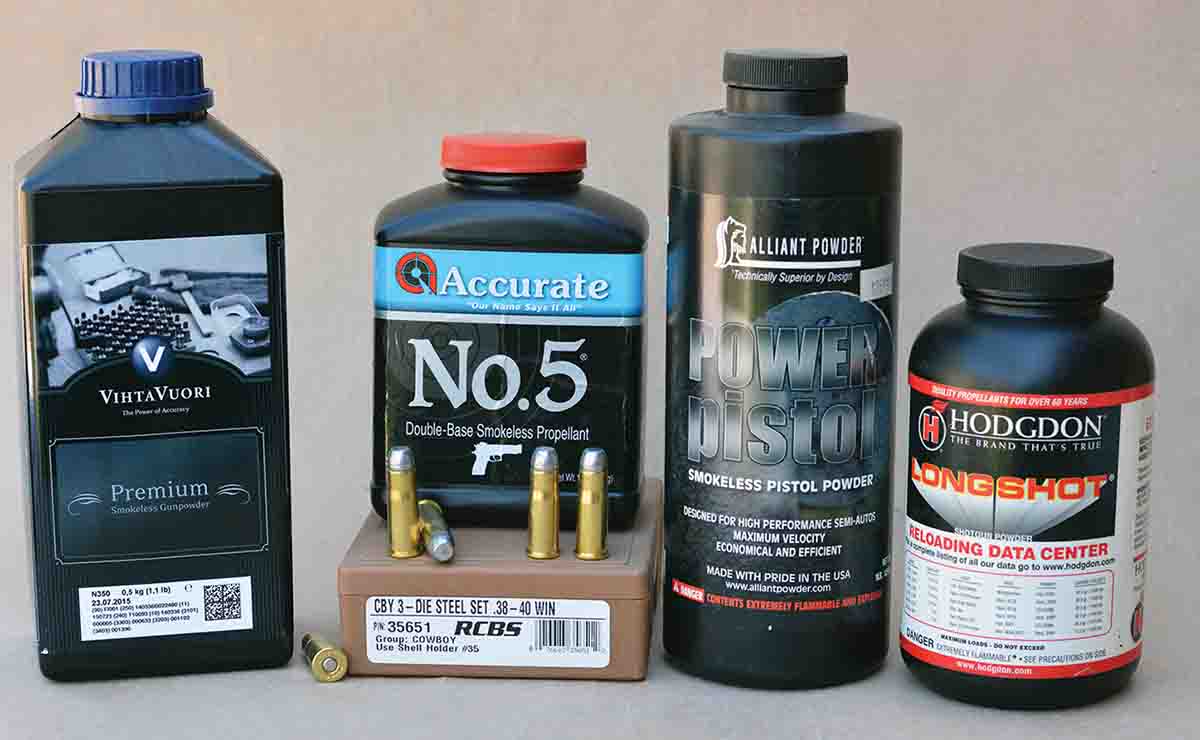
Q: I am a longtime reader of Handloader magazine and respect your articles. I am looking for +P-style loads for my Gary Reeder customized Ruger New Model Super Blackhawk .38-40 Winchester fitted with an 8.5-inch barrel. I would like a powder that is least sensitive to positioning. I will be using 180-grain jacketed bullets with a cannelure. I would like this load to be powerful enough to take whitetail deer or game of similar size.
My everyday plinking loads at cans or targets is a 180-grain LFN-GC bullet that I obtain from Montana Bullet Works. I load it with 6.0 grains of Hodgdon Titegroup powder. I would like you to “OK” this load, or suggest something different.
Once again, thank you for your interesting and knowledgeable articles.
B.Y., Logan UT
A: First, you should enjoy your Gary Reeder custom Ruger Super Blackhawk, as he offers quality and accurate sixguns. Your plinking .38-40 load containing 180- grain Montana Bullet Works cast bullets and 6.0 grains of Titegroup powder is a good load that is within industry maximum pressure limits. Due to this powder being position insensitive, clean burning, etc., it should prove very accurate.
As I am sure you know, the .38-40 started life as a black-powder load. However, when smokeless powders began appearing in the 1890s, the velocity was the same as black-powder loads at around 1,300 fps (from a rifle). By around 1905, factories began offering special high-velocity loads that pushed 180-grain bullets to 1,776 fps and had a chamber pressure of 23,000 psi. Later, they lightened bullets for even higher velocity loads, including a 145-grain at more than 2,000 fps! But these loads were specified for rifles only, such as the Marlin Model 1894 and Winchester Model 1892, and not Winchester Model 1873 or revolvers. However, your Ruger Super Blackhawk is very strong and will easily handle loads at the above pressure level.
Before suggesting a +P-style .38-40 load, it should be noted that the case is thin and will not last particularly long with comparatively higher pressure loads and multiple reloadings. I suggest starting with Starline cases, as they are stronger than competing cases. A few load options include 11.0 grains of Hodgdon Longshot, 13.0 grains of Vihtavuori N350, 12.2 grains of Accurate No. 5 or 10.7 grains of Alliant Power Pistol powder with the 180-grain jacketed bullet. Should you choose to use the Montana Bullet Works 180-grain cast bullet with the above powder charges, you will gain around 100 fps velocity.
Primer Problems
Q: I have been experiencing a problem with my .45 ACP handloads and hope you can provide some insight. I have accumulated several thousand pieces of brass with a variety of headstamps from most major manufacturers, including Federal, Hornady, Sellier & Bellot, Winchester, Remington, Starline and others. Due to their being mixed, I only use handloads assembled in these cases for practice. They have been reloaded many times and I only occasionally discard cases, which is usually the result of a dented case mouth that gets stepped on at the range. My standard load consists of 230-grain RN “ball” bullets from Hornady, CCI 300 primers and 5.5 grains of Accurate No. 5 powder.
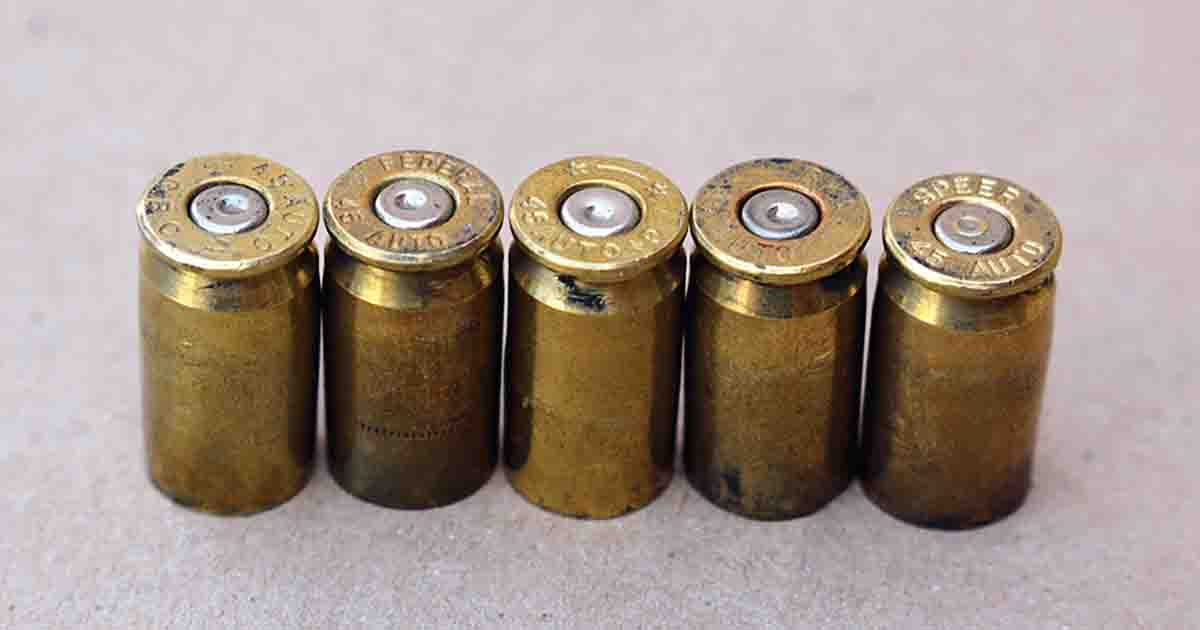
I do occasionally substitute Remington 2½ primers. Depending on which gun I use, the velocity is generally running between 830 and 850 fps, which as you know, duplicates most factory 230-grain ball loads. Extreme spreads are low and accuracy is good. I have been using this load for many years and have fired it in more than a dozen pistols (several manufacturers) and have never experienced any issues related to excess pressure. The slide velocities seem completely normal, while function and feeding are virtually perfect.
However, sometime back I added a few hundred Speer cases into the above batch of mixed brass. They loaded fine and fired without issues; however, when I began reloading my big batch of cases again, I noticed that fired primers loaded in all other manufacturers’ cases appeared normal, but all the fired primers in the Speer cases were completely flat. I tried the Remington primers in Speer cases and they, too, took on the flattened appearance. It almost appears as though the firing pin indent is being pushed back to give the fired primer a convex shape. Clearly, there is something awry. I have forwarded samples for your evaluation. Any insight that you can offer will be greatly appreciated.
Thanks for your help and I very much appreciate your informative articles.
J.P., Sandpoint ID
A: After examining the cases that you forwarded, it appears that the size of the Speer flash holes is the culprit, as they are large. I cannot state that they are out-of-specification, as there are no industry standards regarding flash hole size. Rather, this is left up to individual manufacturers. Most commercial .45 ACP cases feature a flash hole that measures .076 to .081 inch. However, the samples that you forwarded are measuring .099 to .101 inch. This will result in greater pressure to the primer and explains the convex primer shape that you are experiencing. I would suggest discarding these cases and sticking with your proven load. (Note: Current U.S. military contract specifications for .45 ACP flash holes are .078 inch with a plus .004 inch per Winchester (Lake City), which is the same specification that Winchester uses in its commercial loads.)
Bulge Busting
Q: I have been reloading for 40-plus years and have loaded for dozens of cartridges, both pistol and rifle. I have never had an issue. However, in the past year I have started reloading the .380 ACP, as my wife acquired a Glock 42 for personal carry. I have gathered up all the necessary loading components, including an RCBS carbide die set, which in this day and age wasn’t easy or inexpensive!
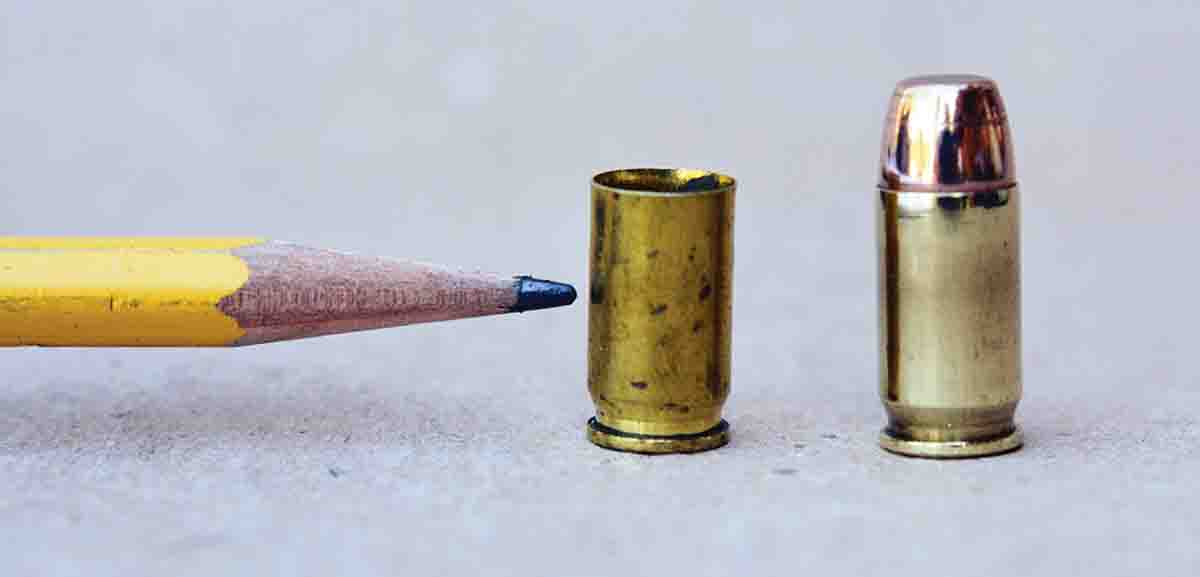
M.M., Chambersburg PA
A: It is unclear if the “bulge” that you reference is just forward of the head, or bulged due to the bullet seating tightly in the case, which also leaves a bulge. First, let’s discuss the bulge that can appear just forward of the head. Many pistols in this caliber leave fired cases with a significant bulge just forward of the head, which can be the result of an unsupported chamber, or the pistol is beginning to unlock while pressures are just high enough to cause the bulge, but not rupture.
The reason your RCBS carbide sizing die is not removing the bulge is a combination of two items. First, the shellholder is .125 inch from the bottom (where the case head rests) to the top, where it normally contacts the bottom of the die. If the die was capable of sizing the brass all the way down to the shellholder, this would remove most, if not all, of the bulge. For example, in measuring the head thickness of popular cases, they typically run between .168 to .178 inch (which is my measurement and not a SAAMI specification). If we deduct the .125 inch of the shellholder depth, this will only leave between .043 to .053 inch of the case that is unsized. However, RCBS dies in this caliber feature a significant bevel that permits fired cases to easily enter the carbide ring. This limits how far down the die will size the case. Furthermore, the carbide ring is crimped in place by the steel die body, which further increases the distance from the top of the head to the case wall where the carbide ring can actually size the case. Dies are designed in this manner to prevent the carbide ring from contacting the shellholder, which can cause breakage (and warranty issues).
I have talked with RCBS extensively regarding this problem and they have no solutions. I might suggest obtaining a second shellholder (in the event that you ruin your original shellholder) and mill the top of it off by around .020 to .025 inch, which will allow the case to insert deeper into the die. (The shellholder may need to be reheat-treated after this modification.) While you probably don’t want to revert to a steel sizing die, wherein cases must be lubed, but they will size the case body closer to the head. Another option is to purchase a Lee Precision carbide sizing die that features less bevel in the carbide ring and, is installed closer to the dies mouth, both of which allows the case to be sized closer to the head. However, the best solution is to purchase a Lee Precision Bulge Buster Kit, which will remove the bulge prior to normal case sizing, neck expanding, etc.
If your bulge is the result of the seated bullet, this may be unsightly but should not cause function issues. In studying RCBS blueprints, the carbide ring is .375 inch at the bottom (or head) and .367 inch at the top that sizes the case body. This latter measurement is .006 inch smaller than industry outside case specifications and explains why loaded cartridges will have an hourglass shape.


